BALI
We both were a bit anxious about sailing to Bali because of the fierce currents that rip through Lombok Channel. There is no tidal data available, and our predictions based on lunar transits were not helpful, so we sought out local knowledge on Lombok before leaving. The summary of that advice was to leave Lombok around 5:00 am, and we did.
As we were leaving the anchorage, a diesel return tube cracked, and we started spilling diesel in to the bilge. Bud has a fairly strong resistance to seasickness, but the smell of diesel is one thing that can quickly vex his gizzard. Nita did not know how to fix this, so Bud had to do it. He fixed it underway, and he survived the fumes remarkably well.
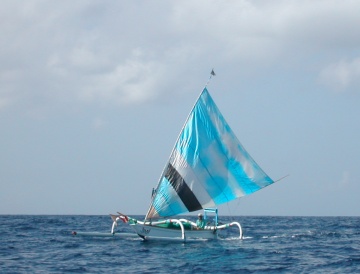
One of hundreds of sailing fishing canoes
As we sipped coffee and watched the sun rise, we began noticing numerous sails on the horizon ahead of us. As we got closer to them, we saw that they were fishing canoes with sails, and they were headed back to Lombok. At first we saw a few, then a few more, then many more. In all, we surely saw at least two hundred of them. It was a beautiful sight. We marveled at the stamina of these men who spend their dark hours out in Lombok Channel on these tiny canoes. And we were concerned about crossing in Passage?
Our crossing remained uneventful for the next few hours. And much to our pleasant surprise, the current was finally with us,
As we neared Bali, the long swell from the southeast grew. And it continued to grow. By the time we were nearing the harbor entrance, the swell was 16 to 20 feet tall. Fortunately we had plenty of depth under us, so it was not breaking; however, we did watch our depth carefully as we approached the harbor. Twenty foot breakers would have ruined our day. But we were out of the swell before we entered shallow water, and all was well.
Bali Marina did not answer our numerous VHF calls, so we briefly hung on an open mooring while Bud ran inside with the dinghy to ask for a slip (they do not accept reservations). Over the next three days, we were in two different ‘med moorings’ (no docks) and finally moved in to a real slip. The marina is very small and falling apart, but it was a relatively safe place for Passage while we tended to pending issues.
As it turned out, these ‘issues’ were not as dire as we had feared, so we were in Bali ahead of plan with a bit of time on our hands. We decided to spend some of it exploring Bali and the remainder getting a few boat chores accomplished.
Although Bali is ‘just’ another Indonesian island, it has a unique history, and it has a unique culture today. Because we unexpectedly found the luxury of spending a little time on Bali, we were anxious to learn a bit about that history and culture.
Bali was probably first populated around 2500 BC by Chinese settlers; however, little is known about its history during many of those years. Its history does, however, record that a fairly evolved culture existed on Bali by 300 BC, and they had developed a complex system of irrigation and rice production that remains in use today. By 500 AD, Bali was a predominantly Buddhist society, but Buddhism on Bali has been largely replaced by Hinduism.
There was a large influx of Hindu and Javanese cultures to Bali in the 11th century. Over the next 200 years, Bali was intermittently self-ruling and ruled by the Javanese. Bali remained Hindu, and there was a large migration of Hindus from Java to Bali as Islam spread through Sumatra and Java during the 16th century. Bali flourished politically and culturally.
Although the Dutch visited Bali in the late 1500s, they did not seek to colonize Bali until the mid-1800s even though they had colonized much of Indonesia since the 1700s. They sent troops to Bali in the late 1800s, and they were aided by the Sasak people of Lombok. The entire island was under Dutch control by 1911.
Bali’s history during World War II paralleled the other islands that were soon to become Indonesia. The Japanese occupied the islands, including Bali, from 1942 to 1945, and the Japanese expelled the Dutch. When the Japanese were defeated, the Dutch tried to regain control of Bali, but they were unable to do so. Indonesia, including Bali, became an independent country in 1949.
Bali is a small island between Java and Lombok. It stretches about 50 miles north-south and about 87 miles east-west. It is just 8 degrees south of the equator, and it has only two seasons –the wet and the dry. Its average temperature is 82 degrees Fahrenheit.
Southern Bali has a gently sloping terrain that hosts numerous rice terraces that are visually beautiful. Northern Bali, which is hilly, produces coffee, copra, spices, vegetables, cattle, and some rice.
Bali’s largest town is Denpasar which is also the capital. The main tourist area stretches from Kuta to Seminyak on the west coast. There are hundreds of hotels, bars, restaurants, and shops along this stretch. It really reminded us of Waikiki in Hawaii – the beach, shops, scams, etc. There are also quieter tourist areas on the north, east, and south coasts. Bali attracts around 1 million tourists to these areas every year.
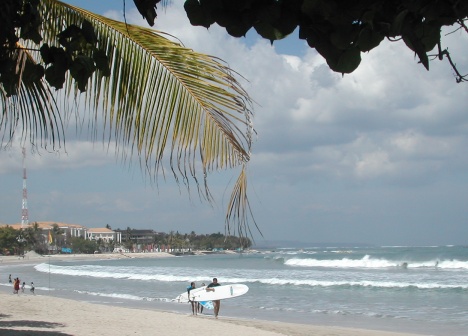
Kuta Beach – reminded us of Waikiki
Approximately 4 million people live on Bali, and most live in village communities with large extended families. Life is very communal. The Balinese maintain their strong family and spiritual roots in spite of the large number of tourists visiting the island at any time.
The vast majority of Balinese – maybe as much as 95% – are Agama Hindu Dharma. This is very different from today’s Indian Hinduism.
Bali is also a cultural blend in its arts. It produces unique styles of painting, stone carving, wood carving, textiles, and dance.
But despite the art and culture, water sports remain the primary focus for visitors to Bali. Diving, rafting, surfing, windsurfing, sailing… There is so much to do!
We have heard the cruising lifestyle described as ‘working on your boat in exotic locations around the world’. We really identified with that as our time in Bali passed much too quickly. Although we did not intend to, we spent almost three weeks on Bali. We spent a lot of time working on the boat and a bit of time playing.
Bali Marina – It would be kind to call the marina ‘rustic’. It appears to be falling apart. It is not inexpensive, so we had hoped for a bit more. However, it is the only marina around for many miles in any direction, so they have control over the market.
We had let our boat cosmetics slip to a point where Passage was looking a bit tired. When we heard that we could hire a ‘boat boy’ for Rp 100,000 (just over $10USD) per day, we decided to spruce her up a bit while here.
We both found the term ‘boat boy’ a bit demeaning, and it seemed particularly so after getting to know our ‘boat boy’ – Hadi. Hadi is a 38 year old father of three. He is multilingual and conversive on current events and world issues. He also works hard and does very nice work. We turned him loose on Passage for a week, and she has rarely looked better. And we also thoroughly enjoyed getting to know Hadi a bit.
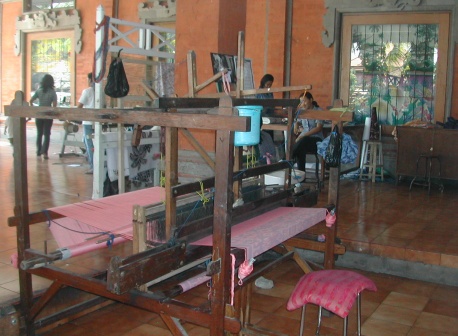
Hand weaving
But our time was not ‘all work and no play’. We worked with Hadi a few days, and we went out to shop and play a few days while he sanded and polished.
Necessary shopping – We were pleasantly surprised by the shopping we found on Bali. Whether hardware or basic provisions, we found everything we needed.
Batik factories – All of Indonesia is known for the beautiful fabrics they produce, and Bali has a few tourist-oriented factories where one can see batik being done and learn about the hand woven fabrics that are available on Bali. We visited three of those factories, and Bud enjoyed it as much as Nita. We were both familiar with the batik process; however, we had not seen pieces go through eight to ten different dye baths. The results are fabric art. And we were both very impressed with the hand weaving of fabrics on looms. We bought a few pieces of the hand woven fabric.
Agung Rai Museum of Art – We visited one of Bali’s best known art museums and thoroughly enjoyed it. We were dazzled by what we saw both outside and inside. We were first struck by the serene beauty of the grounds. The entrance was an arched wooden walkway over a pool with fish. Water was constantly pumped through carved stone statues and fed the pool. The ‘cafe’ was possibly the most beautiful manmade place we have ever had coffee – the lighting, orchids, surrounding landscape. Mesmerizing. And although our appreciation of art is hopelessly amateur, we enjoyed seeing the various styles that have developed through time. It is every bit as colorful and intricate as we expected of Balinese art.
Wood carvings – We visited one of the more ‘up-scale’ (read expensive) wood carving showrooms, and we were awed by what we saw. There were many detailed and intricate carvings, but the most unique were relief carvings of traditional Balinese scenes. Some of these carvings were three by seven feet and up to four inches thick. One carver may spend up to a year carving one of these. We also saw a lot of stone carving, but we did not stop to visit carvers.
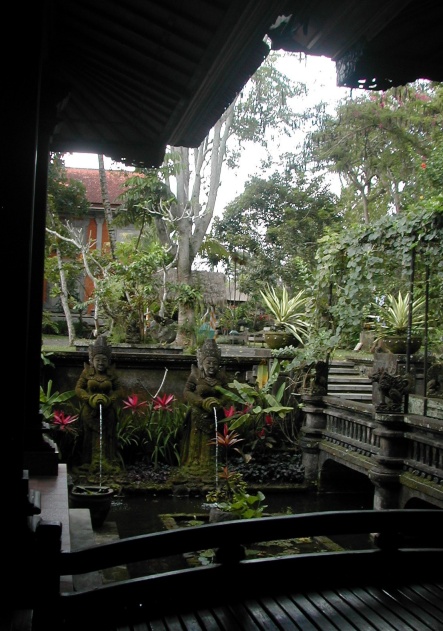
Entrance to the Agung Rai Museum of Art
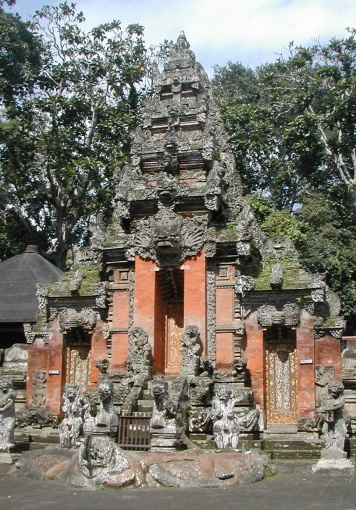
Sacred Monkey Forest Temple
Sacred Monkey Forest Sanctuary of Padangtegal – This site is essentially in the center of the town of Ubud. It is a sacred site including a temple and a monkey sanctuary.
The sacred site and temple – The Monkey Forest of Padangtegal is a sacred Balinese Hindu site. A historical record for temples – the Pura Purana – indicates that a temple was built on this site during the mid-14th century.It was probably built by either the Pejeng Dynasty or the Majapahit Empire. Today, the Sacred Monkey Forest Temple is Padangtegal’s Pura Dalem. The Monkey Temple was characteristically beautiful and ornate. It is a relatively small temple, and the monkeys run freely all over and around it.
The monkeys – There are a few wandering paths through this unfenced area along which more than 200 monkeys live. The monkeys are long-tailed macaques (macaques fascicuiaris), and they have lived here for more than two hundred years – maybe much longer. The macaque likes forested ravines which this sanctuary is.
The long-tailed macaque is a medium-sized monkey weighing less than 20 pounds when full grown. The males are larger than the females, and some currently in the forest are known to be at least seventeen years old.
Although not all macaques choose to interact with humans, these do. They are very accustomed to human contact, and they are hand-fed by both staff and tourists. We took bananas.
One does not need to wait long to be approached by a hungry monkey. They are assertive in what they want. They can even be a bit pushy, but they are only slightly aggressive among themselves – they don’t bite the hand that is feeding them. One large male sniffed-out a granola bar in Nita’s pack and was determined to get it (Nita was determined to keep it). He latched on to the pack and would not let go. Nita picked the pack up off the ground, and she hoisted a large male macaque with it. He eventually let go, but not without a few moments of doubt.
Nita was squatting down to take pictures at eye-level, and a small monkey ran up behind her, ran right up her back, and perched on her shoulder. He was most interested in her hair, and he did not want to get down. He was finally bribed down with food.
The babies were cute beyond description. Eerily human…
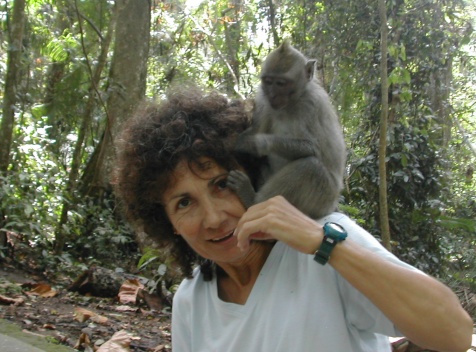
These are very friendly monkeys
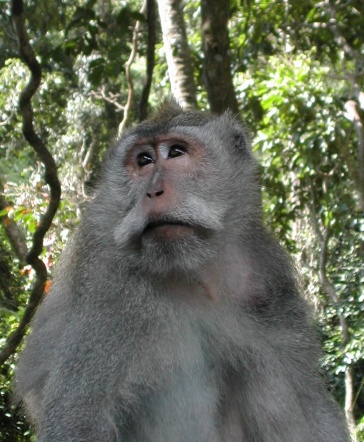
It seems that we must have seen all 200 monkeys in the sanctuary, and we probably saw a few of them more than once. They were everywhere. They were a lot of fun and a great way to spend some time on a warm Bali afternoon.
Ubud Market – This is a typical Balinese street market, and its only unique feature is its size – it is very big. These markets sell lesser quality goods, but they are a lot of fun. We browsed around and bought a few souvenirs.
Balinese dancing – There are numerous traditional Balinese dances, and each tells a story. We saw three dances. The primary performance was a Kecak Dance. These dance are well known because they do not have musicians. Instead, 100 men chant various sounds. We saw the story of Ramayana. We also saw two short dances. One was the Sangyyang Dedari dance in which young girls dance to fend off evil spirits from their community. The last dance was the Sanghyang Jaran dance which is a Balinese form of fire dancing. We had mixed feelings about the dancing. We did not particularly like the Kecak, and we think we would have enjoyed the dancing more with music.
We had much more time in Bali than we expected, but it still was not enough. We stayed busy both working and playing. We accomplished a lot, and we saw a lot, but we know that we scarcely scratched the surface. Bali is a very interesting place that we thoroughly enjoyed, and we wished we had more time.
Bali Marina to Benoa Bay – We had local advice to pass the easternmost point of Bali, Tangung Ibus, before noon, so we left at first light. However, we had 3 ½ knots of countercurrent against us the entire way through Selat Badung, and it was 2:00 pm before we reached the point. On the point, our winds immediately increased to 34 knots, and they were gusting to 39 knots. Seas were bumpy and confused, but fortunately, they were small. All settled down again a few miles around the point, and our anchorage for the night – Benoa Bay – was just a few miles further.
As we neared Benoa Bay, we noticed a few sailboat masts. As we approached, we counted thirteen – we made fourteen. We knew we were getting near the rally group again.
We had to drop our anchor three times to get a good bite, but we felt secure for the night. Our plan was to move on again at first light.
Benoa Bay to Lovina – In the morning, twelve of fourteen boats left in the direction of Lovina. Our winds were very light, and we motorsailed all day. The scenery was, however, very nice.
About midway between Benoa Bay and Lovina we started seeing the beaches completely covered with sailing fishing canoes – every beach completely covered. This went on for miles, and we estimated that we saw well over one thousand canoes and probably many more. We also saw at least one hundred of them in the water. We had no idea that there were that many people on the north shore.
Then we had to face Lovina. Lovina was the most practical ‘jumping-off point’ for us heading northwest to Kalimantan; however, we knew it is also the rally’s only Bali stop. Almost everyone in the rally needed to renew their Indonesian visas while in Bali (we already did ours), so almost everyone in the rally went to Lovina. We knew it would be crowded, but it was worse than we expected.
This is not a great anchorage. It quickly changes from around 23’ to 70’, and boats were everywhere. We did a quick count as were coming in, and we counted 79 boats (there may have been more). We would make 80. After a few circles we dropped our hook in 30’ sand in the tightest conditions in which we have ever anchored. We were hoping that the wind would not change direction during the night (which, of course, it did). We made it through the night without any bumps, and were again off at first light. Although we were a bit sad to leave Bali, we were very glad to get out of that anchorage.
Now we are off to Kalimantan.
Follow us to Kalimantan or return to our Indonesia page.